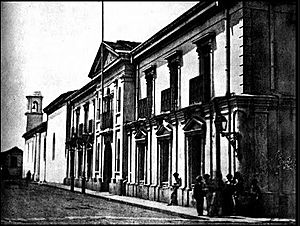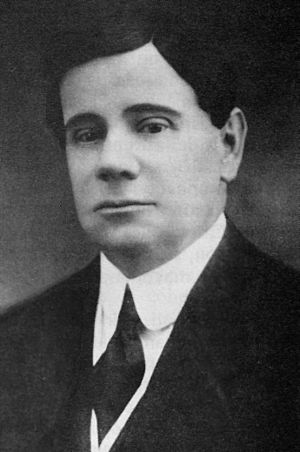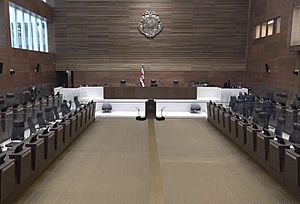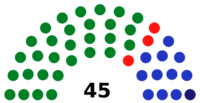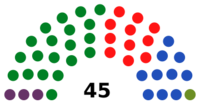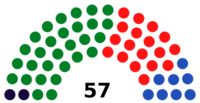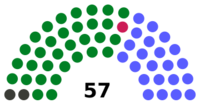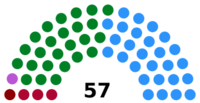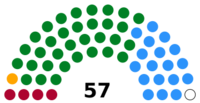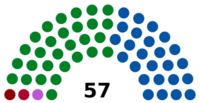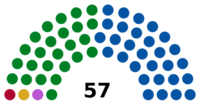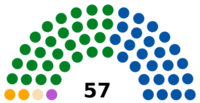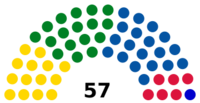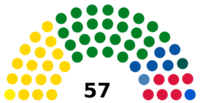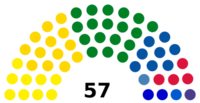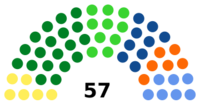History of the Costa Rican legislature facts for kids
The history of the Costa Rican legislature is about how Costa Rica's law-making body has changed over time. This story goes back even before Costa Rica became fully independent from Spain. Costa Rica is known as one of the world's oldest democracies, so its parliamentary history is quite old!
Contents
How Laws Were Made: A General Look
Before Costa Rica became independent, the King of Spain made all the laws. But in 1812, a new Spanish Constitution was created. This constitution said that a group called the Cortes Generales would work with the King to suggest, approve, and change laws. This rule applied to Costa Rica from 1812 to 1814, and again from 1820 to 1821. Some parts of it even made their way into Costa Rica's first laws after independence. Each province elected one representative for every 70,000 people. Florencio del Castillo was Costa Rica's representative.
When Costa Rica gained independence from Spain in 1821, a new set of rules called the Pact of Concord was put in place. This pact governed the country from December 1821 to March 1823. It even considered joining the First Mexican Empire. The Pact of Concord created a Provisional Government Junta, which was a group of seven elected people. This group took over the power to make and enforce laws.
In 1823, Costa Rica had two more temporary rulebooks: the First Political Statute and the Second Political Statute. During this time, Costa Rica was thinking about joining the United Provinces of Central America. Both statutes said that a three-person board, called the Diputación de Costa Rica, would govern the province. This board was also sometimes called the "Congress."
In 1823, Costa Rica officially became a state and joined the Federation. They approved the Federal Constitution of 1823. This constitution separated government powers into different branches. The power to approve laws went to the Legislative Branch. This branch had one main group, called the Federal Congress, with representatives chosen based on population. There was also a Federal Senate, made up of two elected members from each state. The Senate's job was to approve or reject laws.
The Constitution of the Federal Republic of Central America was created in 1824. It kept the idea of two groups making laws: the Congress (which approved laws) and the Senate (which only approved them, but couldn't suggest new ones).
The Fundamental Law of the State of Costa Rica was put into effect in 1825. It lasted until 1828, and then again from 1842 to 1844. This law created a Congress with 11 to 21 representatives. It also set up a "Comptroller branch" with 3 to 5 elected members, who also had a say in approving laws.
During the time of Braulio Carrillo Colina (1841-1842), a new law called the Decree of Basis and Guarantees was made. This law created a "Supreme State Power" led by one strong leader, who had a Consultative Council to help him.
The Political Constitution of 1844 brought back the idea of two law-making groups: a Chamber of Representatives (elected by the people) and a Senate (also elected). Both groups could suggest and approve laws.
The 1847 Costa Rican Constitution and the 1848 Constitution changed things again. The law-making power was given to a Congress with 10 representatives and the Vice President, who led the group. In 1848, this group was called the "Chamber of Representatives."
The 1859 Costa Rican Constitution and the 1869 Constitution went back to a two-group system. They had a Chamber of Senators (two from each province) and a Chamber of Representatives. Both groups could suggest laws.
The 1871 Costa Rican Constitution created a single law-making group called the Constitutional Congress. It had 43 main representatives and 18 backup representatives, chosen based on population. This system was paused during the 1917 Constitution but came back until 1948.
After a major change in government in 1917, a new constitution was made. The Political Constitution of 1917 created a two-group legislative branch again: a Chamber of Deputies and a Senate. Both were elected by the people. Each province elected representatives based on its population. This constitution only lasted two years.
In 1948, after the Costa Rican Civil War, a new government took over. They created the Political Constitution of 1949, which is still used today! This constitution went back to having a single law-making group. It started with 45 representatives, but later, in 1961, the number was set at 57 representatives, and the idea of backup representatives was removed.
Over Costa Rica's history, some leaders had the power to make laws, especially during times of change or when there wasn't a clear government. Some of these leaders include:
- Braulio Carrillo Colina (1838-1842)
- Francisco Morazán Quesada (1842)
- José María Alfaro Zamora (1842-1844 and 1846–1847)
- Juan Rafael Mora Porras (1852)
- José María Montealegre Fernández (1859-1860)
- Jesús Jiménez Zamora (1863 and 1868–1869)
- Bruno Carranza Ramírez (1870)
- Tomás Guardia Gutiérrez (1870-1872 and 1877-1882)
- Vicente Herrera Zeledón (1876-1871)
- José Joaquín Rodríguez Zeledón (1892-1894)
- Federico Tinoco Granados (1917)
- Francisco Aguilar Barquero (1919-1920)
Having Two Law-Making Groups (Bicamerality)
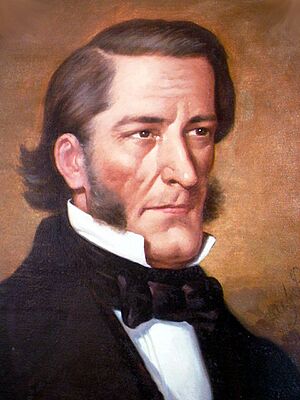
Bicamerality means having two separate groups or "chambers" that make up the law-making part of the government. Costa Rica has had this system at different times in its history.
The Senate of Costa Rica
The Senate of Costa Rica was the upper chamber (the higher group) of the law-making branch. It was part of the government under the constitutions of 1844, 1859, 1869, and 1917. The Senate changed its features and how it was formed under each constitution.
- In 1844, the Senate had five senators and their backups. They were re-elected every year.
- In 1859, there were ten senators per province, and they could be re-elected forever.
- The 1869 Senate had 11 senators per province, elected for three years.
- The longest term for a senator was six years, under the 1917 Constitution.
To be a senator, you usually had to be born in Costa Rica, except for the 1917 Constitution, which allowed naturalized citizens. Most constitutions required senators to be over 44 years old (except 1844, which said over 35). They also couldn't be Catholic priests. The 1917 Constitution also required senators to own property or have a certain income. Senators usually had parliamentary immunity, which meant they were protected from being arrested for most things while doing their job, except for serious crimes.
The Senate's powers changed over time, but often it had more power than the lower group. In 1917, if both groups met together, the Senate's president would lead the meeting. The Senate could always suggest new laws, just like the lower house.
The Lower House
The Political Constitution of 1844 created a Congress with a Chamber of Representatives (the lower chamber) and a Chamber of Senators. This system was removed in 1847.
The 1859 Constitution brought back the two-chamber Congress, with a House of Representatives and a Senate. The 1869 Constitution also kept the House of Representatives separate from the Senate. But in 1871, the parliament went back to having only one chamber.
The Chamber of Deputies of Costa Rica was the lower chamber under the 1917 Constitution. It only existed for two years because the government changed again in 1919, and the 1871 Constitution (with one chamber) was brought back.
The House of Deputies was made up of representatives elected by the people from each province. There was one main representative for every 15,000 people.
To be a deputy, you had to be a Costa Rican citizen (by birth or naturalized for over ten years), be over 25, be able to read and write, and own property or have a certain income. Presidents, vice-presidents, ministers, or local authorities could not be deputies. A deputy's term was supposed to last six years, but this didn't happen because the Chamber didn't last that long. The Senate usually had more power than the Chamber of Deputies.
Current Ideas for Change
Today, the Legislative Assembly of Costa Rica has one chamber with 57 representatives, called deputies. They are chosen through a system where political parties list their candidates. Some experts believe that Costa Rica should have more deputies to better represent all the people, but this idea is not very popular.
For example, a report from the United Nations Development Program suggested increasing the number of deputies to 82. Another study from Northwestern University suggested 115 deputies. A group of important people called the "Board of Notables" also recommended having between 75 and 85 deputies. The "Citizen Power Now Movement" suggests 84 deputies but wants to reduce the number of staff who help them to save money. One lawyer, Diego González, even suggested increasing the number to 143, using a system similar to Germany's.
Most of these ideas also suggest that people should vote directly for their deputies, instead of just choosing a party list.
Changing the Government System
Currently, Costa Rica is a presidential republic. This means the president is both the head of the country and the head of the government. Some people have suggested changing to a parliamentary system. In a parliamentary system, the head of government (like a Prime Minister) is chosen from the law-making body, and the president (if there is one) has less power.
One of the first people to suggest this was former President Miguel Ángel Rodríguez Echeverría in 2001. He thought it could help solve political problems.
The "Commission of Notables" also suggested this change. There's even a bill in the Legislative Assembly that would allow the parliament to choose and remove ministers, and even call for new elections if the president loses their trust. This bill is not being discussed right now. Several politicians and former leaders have supported the idea of switching to a parliamentary system.
A former deputy and minister, Rolando Araya Monge, has said he will propose both going back to a two-chamber system and switching to a parliamentary system.
How the Legislative Assembly Has Changed
| Legislative Session 1953-1958 | Political Party | Seats | |
|---|---|---|---|
| National Liberation Party | 30 | ||
| Democratic Party | 11 | ||
| Independent Republican Party | 3 | ||
| National Union Party | 1 | ||
| Legislative Session 1958-1962 | Political Party | Seats | |
| National Liberation Party | 20 | ||
| National Republican Party | 11 | ||
| National Union Party | 10 | ||
| Independent Republican Party | 3 | ||
| Revolutionary Civic Union | 1 | ||
| Legislative Session 1962-1966 | Political Party | Seats | |
| National Liberation Party | 29 | ||
| National Republican Party | 18 | ||
| National Union Party | 9 | ||
| Popular Democratic Action Party | 1 | ||
| Legislative Session 1966-1970 | Political Party | Seats | |
| National Liberation Party | 29 | ||
| National Unification Party | 26 | ||
| Revolutionary Civic Union | 2 | ||
| Legislative Session 1970-1974 | Political Party | Seats | |
| National Liberation Party | 32 | ||
| National Unification Party | 22 | ||
| Socialist Action Party | 2 | ||
| Christian Democratic Party | 1 | ||
| Legislative Session 1974-1978 | Political Party | Seats | |
| National Liberation Party | 27 | ||
| National Unification Party | 16 | ||
| Independent National Patriotic Party | 6 | ||
| Democratic Renovation Party | 3 | ||
| Socialist Action Party | 2 | ||
| Democratic Party | 1 | ||
| National Republican Party | 1 | ||
| Cartago Agrarian Union Party | 1 | ||
| Legislative Session 1978-1982 | Political Party | Seats | |
| Unity Coalition | 27 | ||
| National Liberation Party | 25 | ||
| United People | 3 | ||
| Costa Rican People's Front | 1 | ||
| Cartago Agrarian Union Party | 1 | ||
| Legislative Session 1982-1986 | Political Party | Seats | |
| National Liberation Party | 33 | ||
| Unity Coalition | 18 | ||
| United People | 4 | ||
| National Movement | 1 | ||
| Alajuelense Democratic Action Party | 1 | ||
| Legislative Session 1986-1990 | Political Party | Seats | |
| National Liberation Party | 29 | ||
| Social Christian Unity Party | 25 | ||
| United People | 1 | ||
| People's Alliance | 1 | ||
| Cartago Agrarian Union Party | 1 | ||
| Legislative Session 1990-1994 | Political Party | Seats | |
| Social Christian Unity Party | 29 | ||
| National Liberation Party | 25 | ||
| United People | 1 | ||
| Generaleña Union Party | 1 | ||
| Cartago Agrarian Union Party | 1 | ||
| Legislative Session 1994-1998 | Political Party | Seats | |
| National Liberation Party | 28 | ||
| Social Christian Unity Party | 25 | ||
| Democratic Force | 2 | ||
| National Agrarian Party | 1 | ||
| Cartago Agrarian Union Party | 1 | ||
| Legislative Session 1998-2002 | Political Party | Seats | |
| Social Christian Unity Party | 27 | ||
| National Liberation Party | 23 | ||
| Democratic Force | 3 | ||
| Libertarian Movement | 1 | ||
| National Integration Party | 1 | ||
| Costa Rican Renewal Party | 1 | ||
| Agrarian Labour Action Party | 1 | ||
| Legislative Session 2002-2006 |
Political Party | Seats | |
| Social Christian Unity Party | 19 | ||
| National Liberation Party | 17 | ||
| Citizens' Action Party | 14 | ||
| Libertarian Movement | 6 | ||
| Costa Rican Renewal Party | 1 | ||
| Legislative Session 2006-2010 | Political Party | Seats | |
| National Liberation Party | 25 | ||
| Citizens' Action Party | 17 | ||
| Libertarian Movement | 6 | ||
| Social Christian Unity Party | 5 | ||
| National Union Party | 1 | ||
| National Restoration Party | 1 | ||
| Accessibility without Exclusion | 1 | ||
| Broad Front | 1 | ||
| Legislative Session 2010-2014 |
Political Party | Seats | |
| National Liberation Party | 24 | ||
| Citizens' Action Party | 11 | ||
| Libertarian Movement | 9 | ||
| Social Christian Unity Party | 6 | ||
| Accessibility without Exclusion | 4 | ||
| National Restoration Party | 1 | ||
| Costa Rican Renewal Party | 1 | ||
| Broad Front | 1 | ||
| Legislative Session 2014-2018 | Political Party | Seats | |
| National Liberation Party | 18 | ||
| Citizens' Action Party | 13 | ||
| Broad Front | 9 | ||
| Social Christian Unity Party | 8 | ||
| Libertarian Movement | 4 | ||
| Costa Rican Renewal Party | 2 | ||
| Accessibility without Exclusion | 1 | ||
| National Restoration Party | 1 | ||
| Christian Democratic Alliance | 1 | ||
| Legislative Session 2018-2022 | Political Party | Seats | |
| National Liberation Party | 17 | ||
| National Restoration Party | 14 | ||
| Citizens' Action Party | 10 | ||
| Social Christian Unity Party | 9 | ||
| National Integration Party | 4 | ||
| Social Christian Republican Party | 2 | ||
| Broad Front | 1 | ||
| Legislative Session 2022-2026 | Political Party | Seats | |
| National Liberation Party | 19 | ||
| Social Democratic Progress Party | 10 | ||
| Social Christian Unity Party | 9 | ||
| New Republic Party | 7 | ||
| Liberal Progressive Party | 6 | ||
| Broad Front | 6 | ||


